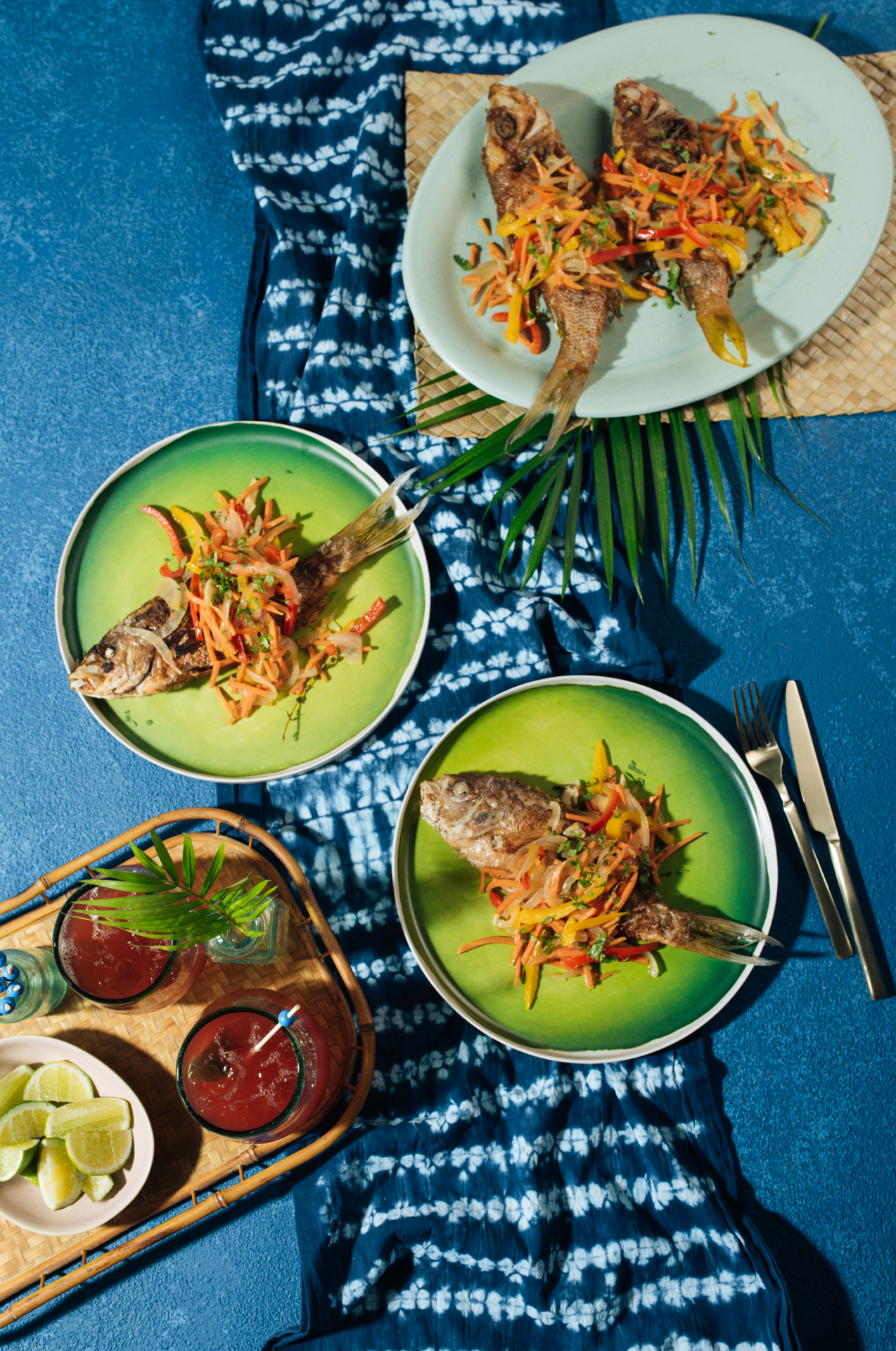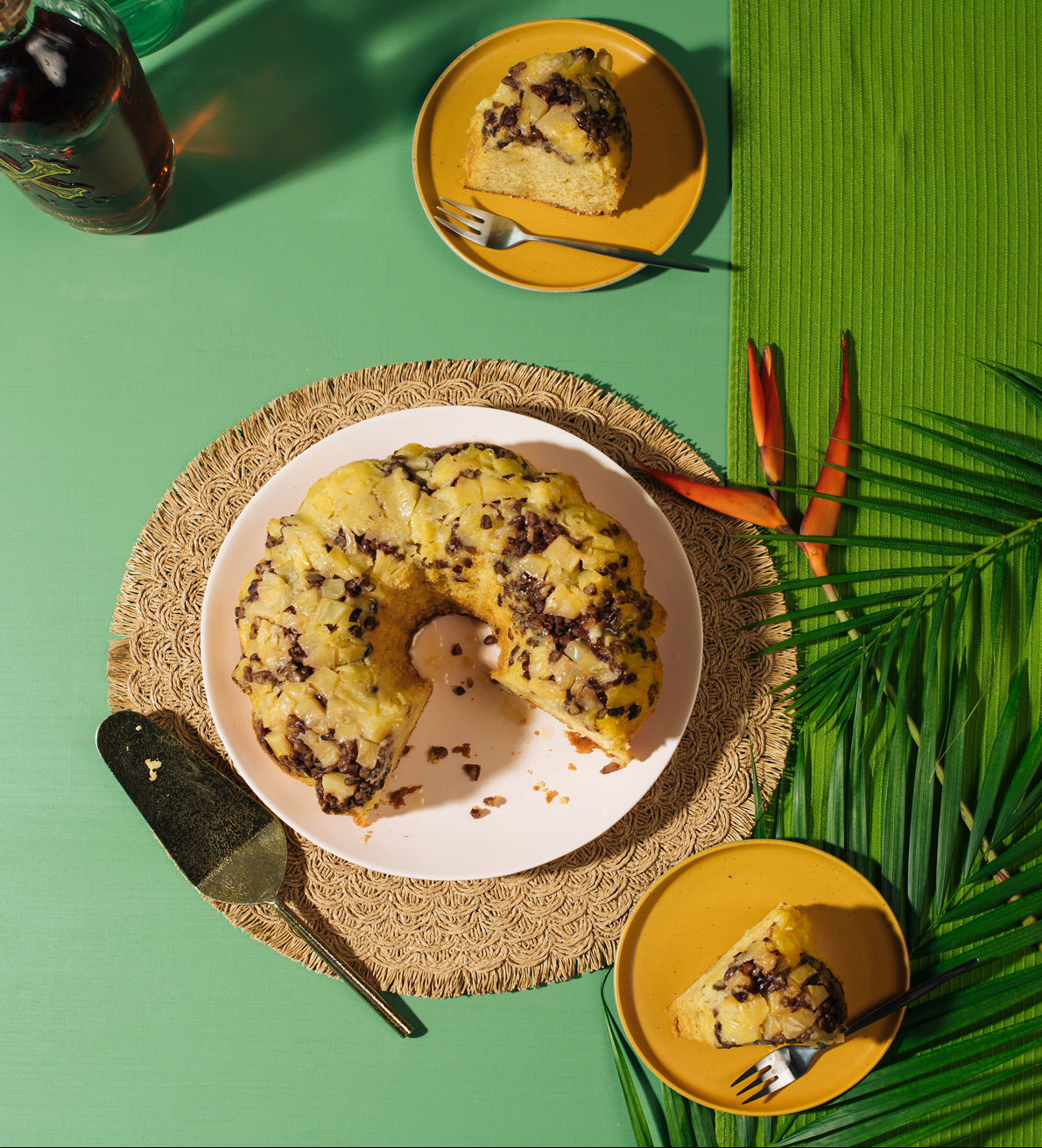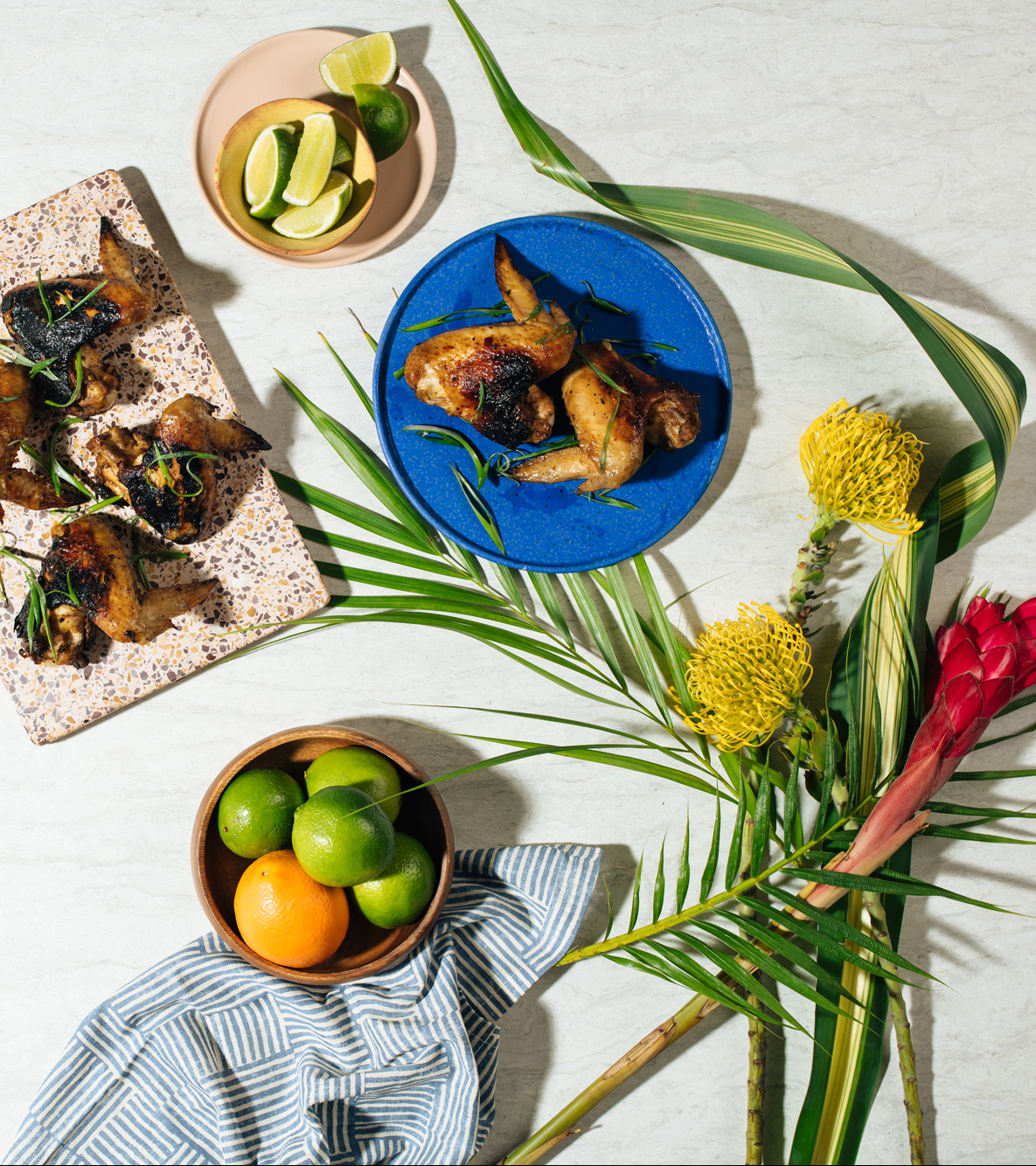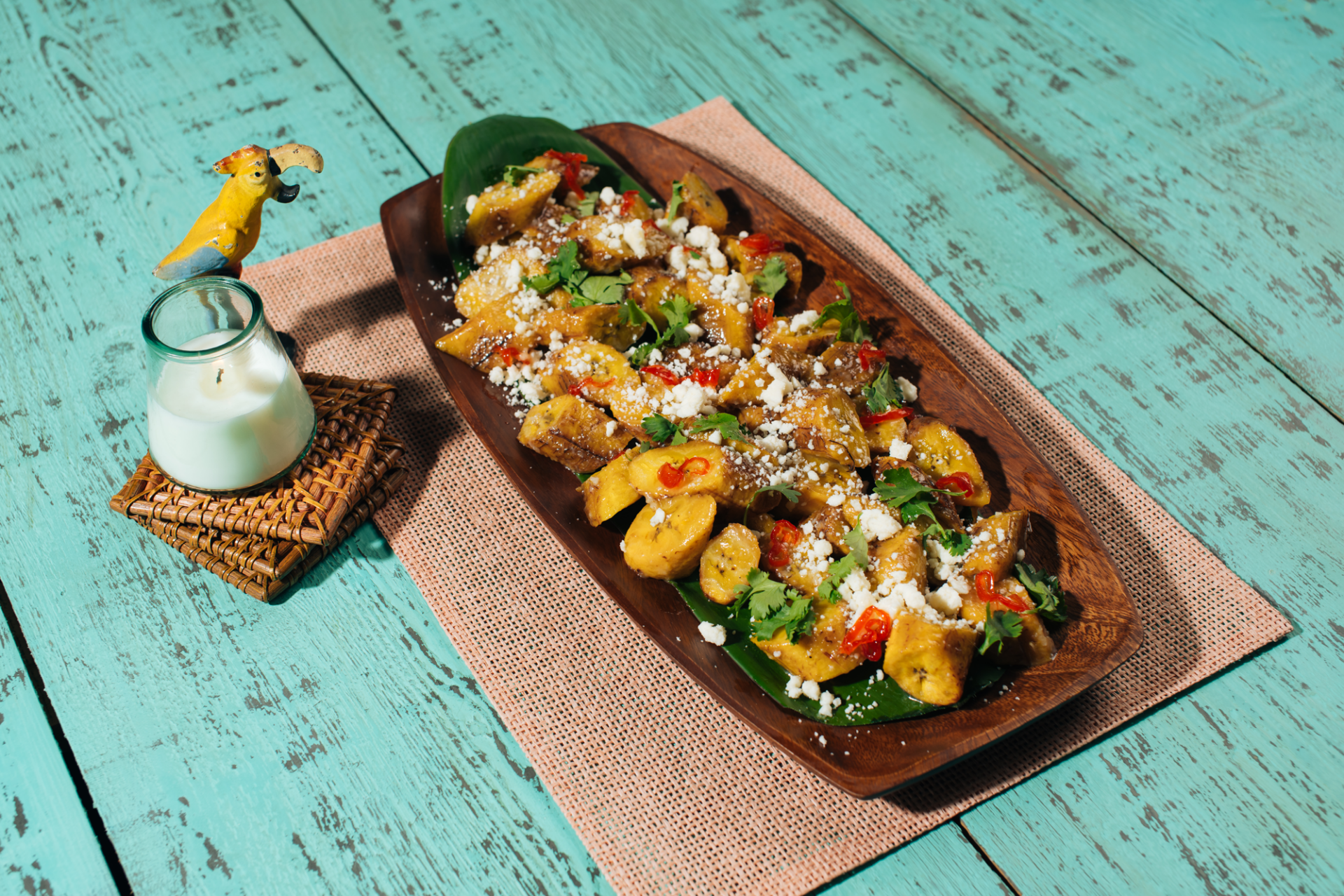Photography by Dan Austin
Prop Styling by Lisa Malott
Antilles [ an-til-eez ]
A chain of islands in the West Indies, divided into two parts, the one including Cuba, Hispaniola, Jamaica, and Puerto Rico (Greater Antilles), the other including a large arch of smaller islands to the SE and S (Lesser Antilles, or Caribees).
Caribbean cuisine is one of the world’s most flavorful and bright cuisines, incorporating flavors from a variety of cultures that have graced the shores of the islands over time. From Africa, France, and Spain to India, Britain, and Asia, these influences, along with the first dwellers of the Islands known to be the Arawak, Carib, and Taino “Indians” have formed the Caribbean’s complex and diverse food culture.
For centuries, many Caribbean islands were under European rule, and many of the region’s signature staples trace their beginnings back to the European and African countries where they originated. The diversity and mixture of these cultures create a unique blend of staple dishes. From seafood delicacies such as Conch to Spanish-influenced ingredients like fruit trees like orange, ginger, plantains, figs, date palms, sugar cane, grapes, tamarind, and coconut. The Americas introduced beans, corn, squash, potatoes, tomatoes, and chili pepper while the English introduced chicken, goat, and curry.
Recently the Caribbean-cuisine movement has become increasingly popular and is embraced by chefs and diners alike. Especially in cities like New York and Miami, where restaurateurs are embracing classic dishes and experimenting with developing new fusion recipes for a more creative approach. In addition, health food stores like Greenwise are making ingredients like breadfruit and cassava readily available due to their use in special diets and health benefits.
For us, it’s the flavors in Caribbean food that make it special, from tart to sweet and spicy, the following staple recipes will transport you to the white sandy beaches of the Caribbean coast.

[accordion]
[item title=”JAMAICAN SNAPPER ESCOVITCH”]
 Jamaican Escovitch, one of Jamaica’s staple dishes. The dish’s tart and spicy notes are simple yet complex––just like its origins and the colonial influences that continue to be a part of the Island’s culture––one of those being Spain’s colonization from 1494 to 1655. This savory dish features a blend of peppers, onions, and carrots cooked in vinegar and served atop flaky, fried red, or yellowtail snapper.
Jamaican Escovitch, one of Jamaica’s staple dishes. The dish’s tart and spicy notes are simple yet complex––just like its origins and the colonial influences that continue to be a part of the Island’s culture––one of those being Spain’s colonization from 1494 to 1655. This savory dish features a blend of peppers, onions, and carrots cooked in vinegar and served atop flaky, fried red, or yellowtail snapper.
The word Escovitch stems from the Spanish word Escabeche, a term that describes a variety of vinegar-marinated fish and meat dishes. The Spaniards, who had been colonized by the Moors for 700 years, borrowed this technique from North African and Middle Eastern cuisines.
Ingredients
Kosher salt
Freshly ground black pepper
2 tsp paprika
1 tsp cumin
4 small red or yellowtail snappers (about 1 lb each), cleaned
Canola oil, for frying
1 bay leaf
2 garlic cloves, crushed
1 scotch bonnet (or habanero) pepper, seeded, and thinly sliced
1 red bell pepper, thinly sliced
1 yellow bell pepper, thinly sliced
1 large yellow onion, thinly sliced
1 carrot, julienned
2 thyme sprigs
½ tsp ground allspice
1 cup vinegar (white, cider, or unseasoned rice vinegar all work fine)
1 tsp sugar
Chopped cilantro and limes, for serving
Directions
In a small bowl, combine 1 tbsp salt, 2 tsp black pepper, 2 tsp paprika, and 1 tsp cumin. Pat fish dry and score both sides of each fish with three diagonal lines. Rub the prepared seasoning all over the fish, inside and out.
In a large skillet, heat oil over medium heat, until hot, add the fish, cook each side for about 4 to 5 minutes per side until golden and crispy on both sides. Remove fish and set aside. Transfer to a paper towel-lined baking sheet to drain while you repeat this step with the remaining fish.
Once finished frying, Drain oil and leave about 2-3 tablespoons of oil and return the skillet to medium heat.
Add bay leaves, garlic, and ginger then stir-fry for about a minute. Add scotch bonnet peppers, bell peppers, onion, carrot, thyme, and allspice; cook and stir for 5 minutes until it begins to soften. Then add the vinegar and sugar, stir, and cook until vegetables are softened for another 4 to 5 minutes.
Season to taste, with salt and pepper.
To serve, transfer fish to a platter and spoon pepper mixture on top. Sprinkle with chopped cilantro and serve with lime wedges for squeezing.
In Jamaica, lime juice, Scotch bonnet peppers, and pimento (allspice) are added to the mix, making the perfect pick-me-up for leftover fried fish. This dish tastes even better the next day, once the snapper has soaked in the marinade. If frying whole fish intimidates you, feel free to substitute individual filets.
[/item]
[item title=”SPICED PINEAPPLE RUM CAKE”]

Rum cakes are a Caribbean Christmas staple, and this version is inspired by my mom’s yearly tradition to make rum cake for our friends and family.
Unlike other rum cakes where the liquor evaporates, this recipe calls for adding an extra pour or two (a half-cup, to be exact) of rum after it is fully baked––retro, boozy, comfort food at its finest!
Most rum cake recipes call for a combination of boxed cake mix and instant pudding mix, but in an attempt to elevate flavor and quality, I have developed a recipe for Spiced Pineapple Rum Cake “from scratch”. I decided to keep the pudding mix in the batter. It adds flavor, moisture, and density, allowing the cake to withstand any amounts of rum syrup drizzled over the cake.
In addition, my recipe calls for Five Spice powder which isn’t traditionally a part of Rum Cake recipes, but I love the aroma and how it compliments the pineapple offering a fuller flavor.
Ingredients
For the cake:
Butter or nonstick cooking spray, for the pan
1 ½ cups diced pineapple
½ cup chopped pecans, toasted
2 cups all-purpose flour
1 1/2 cups sugar
1 (3.4-ounce) package instant vanilla pudding mix
2 tsp baking powder
2 tsp five-spice powder, optional
1 tsp Kosher salt
1 stick unsalted butter, softened
½ cup canola oil
½ cup coconut milk
4 large eggs, room temperature
½ cup rum
2 tsp vanilla extract
For the syrup:
1 stick unsalted butter
1 cup sugar
½ cup to ¾ cup rum, depending on your desired level of booziness
Directions
Heat oven to 325 degrees.
Grease a 9-inch bundt cake pan with butter or cooking spray. Spread the diced pineapple and pecans evenly over the bottom of the pan; set aside.
In a large bowl, combine the flour, sugar, pudding mix, baking powder, five-spice powder, salt butter, and oil. Mix until well combined using an electric mixer; on a medium speed setting. (Please note: the mixture should look sandy) Pour in the milk and mix together.
Add in the eggs one at a time mixing in between each addition with an electric mixer; on a medium speed setting. Then, using a rubber spatula, scrape the bottom and sides of the bowl to break down any remaining flour streaks.
Add in the rum and vanilla extract.
Pour the batter into the bundt pan over pineapple and pecans.
Bake for 50 to 60 minutes or until a toothpick inserted into the center of the cake comes out clean. Allow the cake to cool in the pan while you prepare the glaze.
In a saucepan, melt the butter over medium heat.
Add in sugar and ¼ cup water, stir and bring the mixture to a rolling boil; stirring constantly. Reduce the heat to simmer. Simmer for 5 minutes until slightly thickened; stir in the rum.
Using a skewer or a toothpick, create holes all over the bottom side of the cake. Pour half of the rum syrup over the cake (still in the pan) and wait for it to absorb then pour in the rest. Once the cake has cooled completely, flip the cake over onto a cake plate.
This cake will keep fresh for several days when wrapped at room temperature.
[/item]
[item title=”GRILLED JERK CHICKEN WINGS”]

Jerk chicken may be Jamaica’s most popular dish, and there are about as many recipe variations for it as there are cooks on the island. While these recipes may differ slightly in technique, most can agree upon a marinade based which includes ingredients such as scotch bonnet peppers, scallions, allspice and ginger, in addition to other add-ons such as soy sauce, brown sugar, and lime juice.
Authentic jerk is cooked over a low wood fire, with wood from Caribbean pimento trees (the same tree that produces allspice). As the chicken cooks it simultaneously absorbs the aromas from the burning pimento wood fire smoke, adding to its flavor.
This symphony of sweet, spicy, and smoky flavors, combined with juicy meat and crackly, blistered skin, is the reason why eating jerk chicken is, in my opinion, somewhat of a religious experience.
Ingredients
For the Marinade:
3-5 Scotch bonnet peppers, stemmed, seeded and coarsely chopped (depending on desired spice level)
1 small red onion, chopped
4 scallions (whites and green parts chopped), plus more for garnish
4 garlic cloves
¼ cup cider vinegar
¼ cup soy sauce
2 tbsp olive oil
2 tbsp brown sugar
1 tbsp fresh thyme leaves
1 tbsp grated ginger
1 tbsp allspice
Zest and juice of 1 lime
Zest and juice of 1 orange
For the Chicken:
3 lbs chicken wings
Kosher salt
Directions
In a food processor, combine all marinade ingredients until smooth. Set aside a ½ cup of sauce for basting; store it in the refrigerator.
Place the chicken wings in a large bowl or resealable bag and pour in the jerk marinade. Turn thighs and drumsticks several times to coat. Refrigerate for at least 4 hours overnight.
When ready to cook, set the grill to medium heat on one side and the remaining burners to medium-low heat for indirect cooking.
Remove the chicken wings from the marinade and season with salt. Place the wings on the medium-low side of the grate, cover, and turn occasionally with tongs for 20 minutes.
Uncover and baste the wings with the refrigerated marinade. Transfer the wings onto the grate over the hottest part of the grill and cook for 3 minutes. Flip and baste once more, cook for an additional 4 minutes, until crisp and cooked all the way through.
Transfer wings to platter, sprinkle with scallions, and serve with lime wedges.
[/item]
[item title=”SWEET PLANTAINS WITH HOT HONEY BUTTER”]

From Puerto Rican Mofongo to Dominican Mangú to Haitian Banan Peze, the humble plantain has become synonymous with Caribbean cuisine. However, surprisingly, plantains were not always native to these regions, instead we can trace their origins back to Southeast Asia until trade routes transported them to Africa and then via the trans-Atlantic slave trade, to the Caribbean. The staying power of the plantain in the Caribbean is no doubt due to its versatility, it can be cooked in both it’s ripe and unripe form. In this recipe, very ripe plantains (maduros) are used. This means that when picking your plains you want to look for the ones that have mostly blackened.
Ingredients
4 to 5 large very ripe plantains
1 ½ cups canola oil, for frying
1 habanero pepper, stemmed, seeded and thinly sliced
1 large garlic clove, grated
¼ cup honey
4 tbsp unsalted butter
Kosher salt
3 tbsp cider vinegar
4 oz queso fresco, crumbled
Chopped cilantro, for serving
Directions
Trim ends of plantains. Use a paring knife to make a lengthwise cut over the peel (be careful to not cut into the flesh). Remove the plantain peel and discard.
Slice at an angle diagonally into 1-inch pieces.
Heat oil in a large skillet over medium-high.
When the oil starts to shimmer, fry half of the plantains. Turn once, until beginning to brown, 2 to 3 minutes per side, or until the plantains are golden and edges are caramelized.
Transfer to a paper towel-lined sheet tray to drain while you cook the remaining plantains. After all plantains are fried and drained, transfer them to a cookie sheet and place in the oven to keep warm while you prepare the hot honey butter.
In a small saucepan, combine habanero, garlic, honey, butter, and a pinch of salt. Simmer over low heat; stir in vinegar.
To serve, transfer the plantains to a platter and drizzle with the hot honey butter. Sprinkle with queso fresco and garnish with cilantro.
If you’d like to cut recipe prep time in half, you could even buy frozen sweet plantains. Warm these up in the oven and then toss them in the recipes hot honey butter. For a milder heat level, use a jalapeño pepper instead of habanero.
[/item]
[/accordion]
